Officials share proposals in advance of upcoming aquatic center subcommittee meeting
- Home
- Officials share proposals in advance of upcoming aquatic center subcommittee meeting
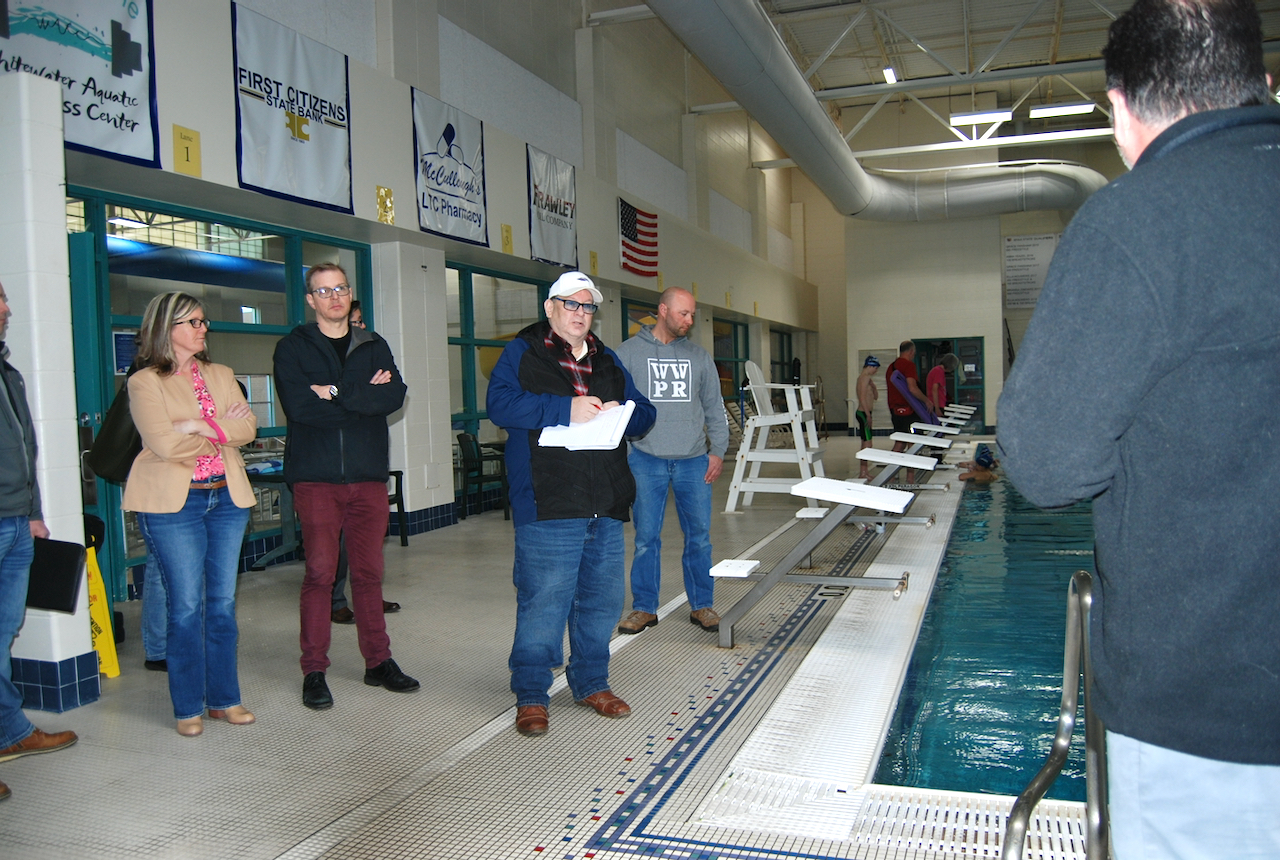
Officials share proposals in advance of upcoming aquatic center subcommittee meeting
By Kim McDarison
City of Whitewater and Whitewater Unified School District officials have drafted proposals for future operations of the Whitewater Aquatic and Fitness Center, with a wide gap in terms offered between the two negotiating parties.
The two proposals are anticipated to come before the Whitewater Aquatic and Fitness Center Subcommittee during its next meeting, which will be held Thursday, May 11.
The subcommittee held its first meeting to negotiate a new contract between the city and district in March. A second meeting was held in April.
Two proposals
According to information shared with Fort Atkinson Online, city officials have proposed a 15-year agreement, which, Whitewater City Manager John Weidl stated in a recent email, “closely resembled the preexisting arrangement.”
The city and the district have operated the facility jointly through several negotiated contracts between 2001 and 2021, after which a contract, drafted by the city in 2021, went unsigned by the district. Earlier contracts between the city and the district shared the facility’s expenses equally between the two parties.
According to information shared by Weidl, the city’s proposed document stipulates that each organization — the city and the school district — would contribute $219,000 toward the facility’s expenses, which would require each organization to borrow or otherwise identify and earmark monies for capital equipment at a rate of $70,000 per year.
“The operational contribution is indexed at 3% per year,” Weidl noted, adding: “All of our budget assumptions moving forward have assumed increases for member growth at 5% per year and increases to membership fees per year at 3%.”
According to Weidl, the school district has proposed a contractual agreement which would be in effect for the next one to three years, and requires the city to absorb the facility’s operational costs in full. The proposed document stipulates that the school district would only assume responsibility for any borrowings associated with maintaining the facility.
Weidl noted that the district has offered to provide a $7,500 fee for its use of the facility for athletic and summer programming, but, he stated, the district’s usage of the facility creates costs of approximately $60,000.
“Their volume alone necessitates having the entire pool heated 365 days a year, which carries additional costs,” he wrote in an email to Fort Atkinson Online.
He cited summer programming, swim lessons, and high school athletics as among activities that place “a huge burden on the facility in a way that eats into the facility’s ability to raise revenue from other programming at this time.”
A proposal comparison, as shared with Fort Atkinson Online by the school district, notes that the proposed 1- to 3-year contract can be achieved without going to a referendum, further proposing that the district become responsible for maintenance, including: maintaining the building’s envelope, defined as roofs, windows, doors and masonry, along with the facility’s parking lots, HVAC, lighting, fire alarm systems and the pool floor. The proposal makes the city responsible for all of the facility’s operating costs, including utilities, pool chemicals, play structures and fitness equipment.
The district also proposes that it keep an annual budget of $250,000 in its Fund 80, a fund designated to cover district-supported community programming, for capital improvement expenditures and provide the city with a rental fee of $7,500, with those monies meant to cover the costs of summer school and the “swim season.”
Under a heading titled: “Deficit,” the district notes that, under the city’s plan, each entity would be held accountable for $222,008. The district is instead proposing that it be held accountable for $150,000 and the city would pay $300,000.
Horizon of repair needs
During the subcommittee’s last meeting, held April 11, the district introduced a document prepared at its request by J.P. Cullen, outlining some $5 million in capital improvements that could be made over a five-year period.
During the meeting, subcommittee member and city representative Lisa Dawsey Smith asked city staff to review the report and create a capital improvements “horizon of repair needs,” detailing more granularly which items on the J.P. Cullen report required prioritization.
Looking more broadly at the report, and assuming all the items would be required within a five-year window, the district’s Director of Buildings and Grounds David Friend, noted that expenses might be spread out over the five years at a cost of $1 million per year, with each entity, the district and the city, responsible for half, or $500,000 annually.
The full itemized report from J.P. Cullen is here: https://www.whitewater-wi.gov/AgendaCenter/ViewFile/Item/7281?fileID=28796.
A story about the April meeting of the subcommittee is here: https://fortatkinsononline.com/aquatic-center-subcommittee-considers-5-million-in-improvements-non-binding-referendum/.
In a recent email, Weidl wrote that the city, when looking at capital improvements, “has consistently said it will cost $140,000 per year and hasn’t changed its math.”
He expressed concern over the “mathematical discrepancies.”
Two options from a city perspective
In a memo from Weidl to Whitewater Parks and Recreation Director Eric Boettcher, a comparison between the two proposed contracts was outlined. Making comparisons over a three-year period, Weidl wrote that the option proposed by the city assumes an expense growth rate of 3% each year within a three-year period, a monthly membership rate growth of 3% each year, and a total membership growth of 5% in 2024 and 2025, and 3% in 2026.
Within the memo, “Option A,” which is denoted as the district’s recommended option, identifies the district as the lessor/operator, and makes the district responsible for “all capital improvements amounting to $250,000 per year,” as estimated by the district. Weidl noted in the memo that the city’s estimates for capital improvements is $140,000 per year. The district, within Option A, would contribute an additional $7,500 to fund school use of the aquatic center. The city would be responsible for covering costs associated with all other operational expenses, including utilities and chemicals. In the memo, Weidl noted that, would the city continue to contribute $128,000 toward operating expenses each year, operating shortfalls would occur as follows: $301,267 in 2024, $288,306 in 2025, and $282,910 in 2026.
As outlined in the memo, using “Option B,” which is denoted as the “previous agreement format of (a) 50/50 split,” each of the two entities, the district and the city, would be responsible for a payment to support operational costs of $219,000 in 2024, with that number increasing in subsequent years by an inflation rate of 3%. A total payment of $140,000, which would be split between each entity, would be placed in a capital improvements fund, which, the memo noted, is detailed in the city’s Capital Improvement Plan (CIP). According to the memo, “this would amount to an estimated surplus of $1,233 in 2024, $23,394 in 2025, and $38,190 in 2026.
Looking at a balance sheet generated by the city and using figures from Option A, under a heading of Aquatic Center — other financial sources, the district would contribute $7,500 and the city would contribute $128,000, for a total of $135,000. When added to such revenue sources as memberships, day passes, classes, room and facility space rentals, and income generated from the concession stand, gift certificates and donations, among others, the facility’s total operational revenue in 2024 is $551,203.
On the expense side of the balance sheet, in 2024, total operating expenses are calculated at $852,470, leaving an operating deficit in 2024 of $301,267.
A capital revenues and expenses balance sheet developed over a six-year period, 2021 to 2026, shows that in 2021, with each entity contributing $50,000, the facility had revenues of $100,000 and expenditures of $9,990, leaving a balance of $90,010; in 2022, with each entity contributed $50,000, the facility showed revenues of $100,000, and expenditures of $18,275, leaving a balance of $81,725; in 2023, the balance sheet shows a revised budget, with each entity contributed $50,000 for a total of $100,000, with no money spent on improvements this year, according to the document. In the years 2024 through 2026, the document shows revenues to be contributed by the school district in an amount between $140,000 and $148,526, with no improvements identified.
Looking at Option B, each entity would be expected to contribute $219,000 toward the operational expenses of the facility, bringing a total amount through “other financial sources” of $438,000, which, along with revenues brought from such sources as memberships, day passes, classes, room and facility space rentals, and income generated from the concession stand, gift certificates and donations, among others, would provide a total operating budget in 2024 of $853,703.
In 2024, on the expense side of the budget, total expenditure are calculated at $852,470, leaving a balance of $1,233.
A capital revenues and expenses balance sheet developed over a six-year period, 2021 to 2026, shows the same revenues and expenses, between 2021 and 2023, as the document developed in Option A. Continuing with the 50/50 split concept, in 2024, each entity would be responsible for a contribution of $70,000, creating total revenues of $140,000. Contributions made by each entity would increase to $72,100 in 2025, and $74,263, in 2026.
The full balance sheet from the city’s Fund 247, the Aquatic Center Special Revenue Fund,” is here: http://fortatkinsononline.com/wp-content/uploads/2023/05/Memo-WAFC-Options-A-and-B-1.pdf.
An equipment list and replacement plan, as developed by the city, also has been shared with Fort Atkinson Online. A link to the list is here: http://fortatkinsononline.com/wp-content/uploads/2023/05/Citys-equipment-list-.pdf.
The city also has generated a “Whitewater School District Facility Use Summary,” which, Weidl noted, shows a breakdown of operating expenses associated with facility use by the school district.
According to the document, some $63,133 in district programming expenses is attributed to “facility costs,” represented in 660.5 hours at a cost of $50 per hour, for a total of $33,025, and “staffing costs,” coming at a cost of $30,108.
The document further outlines costs associated with summer swimming lessons, attributing costs of $40 to each of 215 children who use the program, for a total cost of $8,520 for the district’s swim program. Costs associated with the program’s staffing include monies paid for lifeguards and instructors.
Also itemized within the document are costs associated with the district’s swim team pool use.
The full itemized document as presented by the city is here: http://fortatkinsononline.com/wp-content/uploads/2023/05/WUSD-Facility-Use-Summary.pdf.
A shift in funding allocations
In August of 2022, the school board received, during its regularly scheduled meeting, a preliminary budget presentation from the district’s Director of Business Services Ben Prather.
Aided by slides, Prather noted that the August budget was preliminary and would likely be revised in October, after the district received its levy certification from the state.
Offering a slide, Prather, defining highlights, cited the district’s Fund 39 debt.
“That has dropped about $2 million from our last levy, so that’s from our debt defeasance,” he said.
Prather noted that the district had been “putting money away” into its Fund 41, with the goal of repairing “aging buildings.”
Additionally, he cited the district’s Fund 80, which is used to fund community-based programming, including the aquatic center, he said.
Looking at expenses identified within the preliminary budget in Fund 80, Prather said: “The big jump is the aquatic fitness center. There is a lot of big costs, we had C.G. Schmidt audit this back in January and they quoted about $2 million in expenses that we maintenance. I thought this was an opportunity for us to be able to be prepared for when our boilers break, when our HVAC does shut down, and when we need to replace the aquatic center pool surface, which has been quoted as, since they drained it, needs maintenance and repair, so this is what Fund 80 looks like.”
The slide showed an allocation of approximately $1.3 million for aquatic center expenses.
After the presentation, board member Larry Kachel said: “You’re saying you are going to need $1.3 million in the Fund 80 designated for the aquatic and fitness center.” He asked: “That money would come from where?”
Prather responded, saying: “That’s built into the levy.”
Prather said the district would plan to pay approximately $7,000 for pool use by the swim team. He cited a figure of $130,000 as an ongoing obligation to the pool.
Kachel noted that he believed the district’s obligation to the aquatic center would be increasing. He cited a figure of $178,000. He asked if that money would come from Fund 80.
Prather said it would.
Citing the C.G. Schmidt report, Kachel asked: “And then $2 million is assumed to be a split on the cost between the city and the school district?”
Prather said a meeting was planned between the city and the district to discuss that number, noting his proposed budget was “very preliminary.” He added: “This is assuming that we’re prepared for a rainy day that’s coming, because there is maintenance that is especially needed.”
Kachel asked if the building’s roof was included in the preliminary numbers.
Prather said that he was estimating roof repairs at $200,000, and was advised by Friend that the expense was “something that the city expects the school district to pick up.”
Board member Maryann Zimmerman expressed concern about costs associated with the pool, calling the aquatic center a “money dump.”
She suggested the district might look into another organization, such as the YMCA, to operate the facility.
“The city doesn’t know how to do a pool, we probably — its too much for us. It’s a lot of money,” she said.
Additionally, she asked if the board could request from the city to see its books, asking: “How much are they making? Like has anyone seen their books? Can we see their books?”
She described information shared with the board about the aquatic center’s operational income as “kind of nebulous.”
“I know the community needs it and the community wants it, but it kind of looks like it’s falling to the school district to pay for this and it’s a lot of money on top of like everything else,” she said.
Said Prather: “I think some of the issues were inherited from when this partnership (with the city) began in 2016, but they do have operational budgets that we can get our hands on and share with the board, absolutely. Again, this is just a preliminary look; this is just ideas that, that hey, these are some liabilities that maybe we can tackle or at least be prepared to tackle. So we are not committing anything, we’re going to revise this whole budget come October, we’re going to have a lot more discussion, but that was something that was outlined, and I thought, hey, maybe the district needs to be prepared.”
Then-board member Steve Ryan, who also was a member of the city’s Parks and Recreation committee which operates the pool, said that while he agreed with Zimmerman that the preliminary budget showed figures that were “hard to look at,” he said upcoming maintenance expenses could be attributed to the building’s age, adding that the building was 24 years old.
“We own it and the city runs it. We are in cooperation,” he said.
He noted that some of the building’s equipment, like boilers, was reaching the end of its lifespan.
Last October, the board approved its revised budget.
During his October budget presentation, Prather showed a slide noting that the total allocation of funding in Fund 80 was $318,000. A breakdown of monies allocated for items within Fund 80 was not provided.
Said Prather: “Fund 80, that’s anything that involves the community, so that’s the aquatic center, middle school athletics — we are opening it up to all families — homeschooling in the district, our EL programs for adults after school.”
Prather said the budget would require a total levy of $16.9 million, which he described as a reduction of more than $1.2 million from the previous year’s levy.
“One other thing to really highlight is the overall ask from the school district’s portion of the levy went down $1.2 million. Part of that was debt defeasance, so the district’s ask is less than the overall levy, that’s why it went down,” he said, adding: “We can say with confidence that we are asking the taxpayers for $1 million less than what we did last fall.”
Comments from residents
During the board’s most recent meeting, held April 24, Kachel, who was elected school board president, stated that he was officially stepping down from the Whitewater Aquatic and Fitness Center Subcommittee and noted that board member Miguel Aranda was officially taking his place. Aranda was seated among subcommittee members representing the school board during the subcommittee’s meeting held in April. School Board member Lisa Huempfner also was appointed to the subcommittee. She will be filling the seat vacated by former board member Thayer Coburn.
During public comments, several community members came forward, including Geoff Hale and Guy Ledwell, both of whom are organizing members of a community group called “Save the Pool,” which was formed after the first meeting of the subcommittee held in March.
A link to a story about the group, and its first meeting, held in April, is here: https://fortatkinsononline.com/save-the-pool-community-members-assemble-regarding-aquatic-center-negotiations/.
Hale also read comments provided by Jeff Knight, another organizing member of the Save the Pool group, who, Hale said, was unable to attend the meeting.
Addressing school board members, Hale said his topic of discussion was ESSER funds, which he described as monies received by school districts through a federal program called Elementary Secondary School Emergency Relief. The program was formed to help school districts statewide with funding options during the COVID-19 pandemic.
Said Hale: “If it smells fishy, if it sounds foolish, if it looks foreign, it’s likely foreign, foolish and fishy. It’s likely you might be getting scammed. Time and again requests from concerned citizens to disclose how our ESSER funds were used have been repeatedly stonewalled by our superintendent.”
Hale asked the board to provide an accounting of how the district’s ESSER monies were spent.
“We ask for transparency and full disclosure for how the ESSER monies were utilized,” he said.
He called the district’s sports program “failing,” adding that, “Great sports teams are built from great leadership and inspirational coaching.”
He suggested that the district should consider looking to members of the public who were not necessarily members of the district’s staff to secure “fantastic coaches to help us excel in sports.”
He next read a statement from Knight, the full text of which has been shared with Fort Atkinson Online.
Within his statement, Knight said he was commenting as a member of the Save the Pool group. He, too, asked for a better understanding from the district about its use of its ESSER funds, and information about how it might spend any remaining ESSER dollars. He requested that the board consider allocated some portion of any remaining ESSER fund to pay for equipment at the aquatic center.
In his statement, Knight wrote: “My second focus would be on the preliminary budget number published in your August 2022 agenda showing $1,365,475 for the WAFC. What was really difficult for me as I was going through your official minutes was to understand how all that proposed allocation disappeared. It would be helpful for everyone in the community if the school board could explain their action so we could better understand why that was done.”
Ledwell, too, asked for information showing how the district’s ESSER funds were allocated, asking the district to provide information “at a somewhat granular level, not generalizations,” along with an accounting of any future uses for any remaining funds.
Said Ledwell: “Another something else that I don’t quite understand, I was looking at the budget for 2022-23, and I saw like $1.3 million in there, is what I saw for the aquatic center, and I was wondering where that went to or how that might have been spent or used?”
School district resident Mark Maas, too, asked about the ESSER funds and the approximately $1.3 million that had been previously proposed by the district to support the pool. He encouraged the board to consider grant writing for pool funding, and said he would ask city officials to consider the option as well.
In a recent telephone interview, Kachel said monies moved from the district’s Fund 80 were used to pay down debt service.
Among monies remaining in the fund, he said $178,000 was earmarked for the pool, with the remaining funds required to cover costs associated with other Fund 80 expenses.
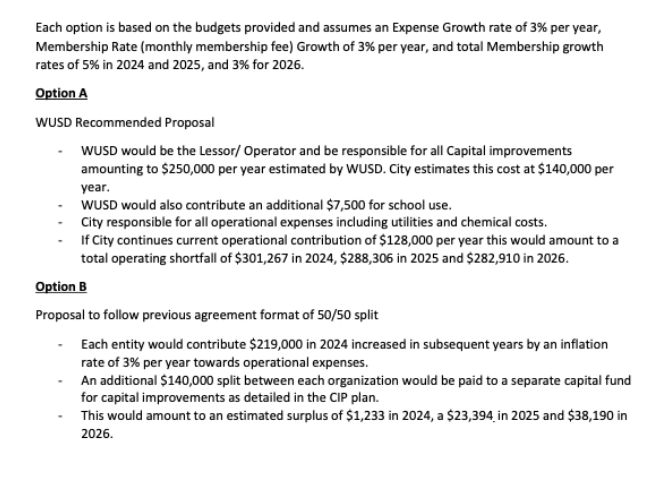
A comparison, offered above, of the two aquatic center proposals as produced by Whitewater City Manager John Weidl.
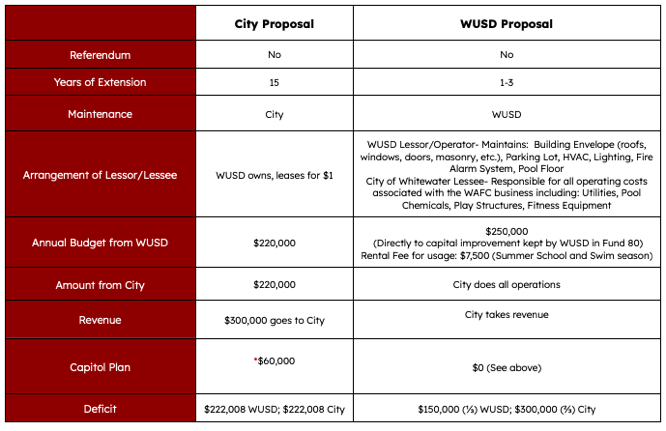
A comparison, offered above, of the two aquatic center proposals as produced by the Whitewater Unified School District.
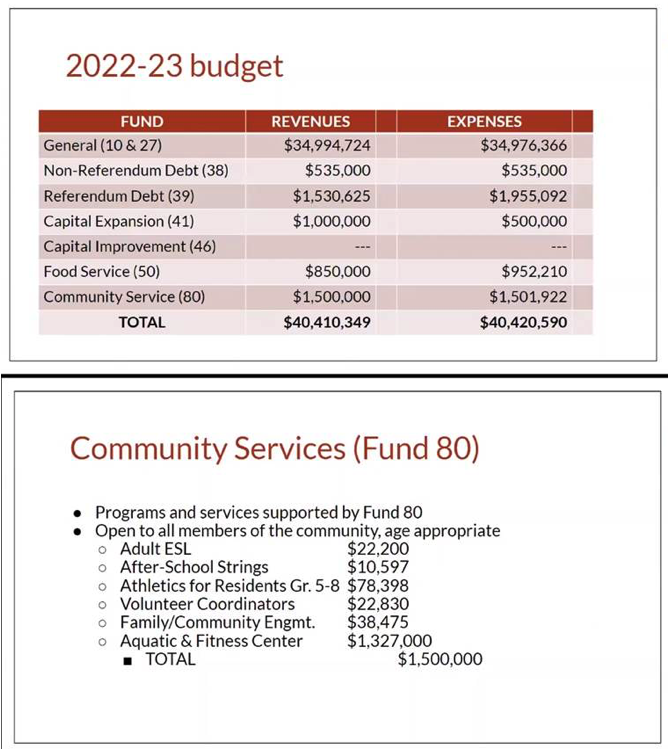
Two slides above, as shared during a presentation in August made to the Whitewater Unified School District Board of Education by Director of Business Services Ben Prather, show the full 2022-23 preliminary budget of $40.4 million, at top, including a proposed allocation of $1.5 million within the district’s Fund 80. A second slide, also shared in August, shows the breakdown of allocations within Fund 80, including approximately $1.3 million for the aquatic and fitness center.
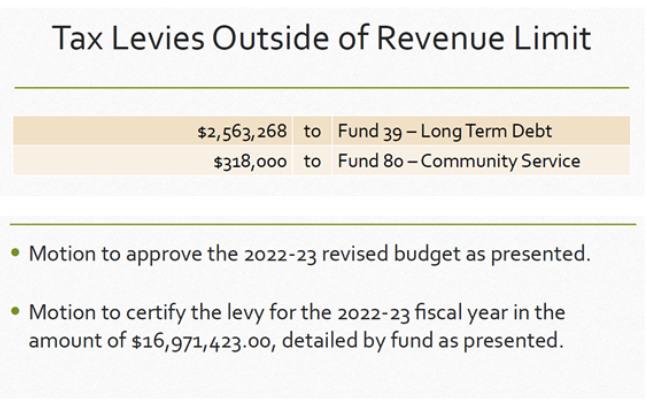
A slide, above, shows funds of $318,000 placed in Fund 80 as part of the district’s revised budget approved by the board last November. According to School Board President Larry Kachel, funds previously placed in Fund 80 in August were instead used for debt defeasance, which enabled the district to reduce its taxpayer levy by $1 million.
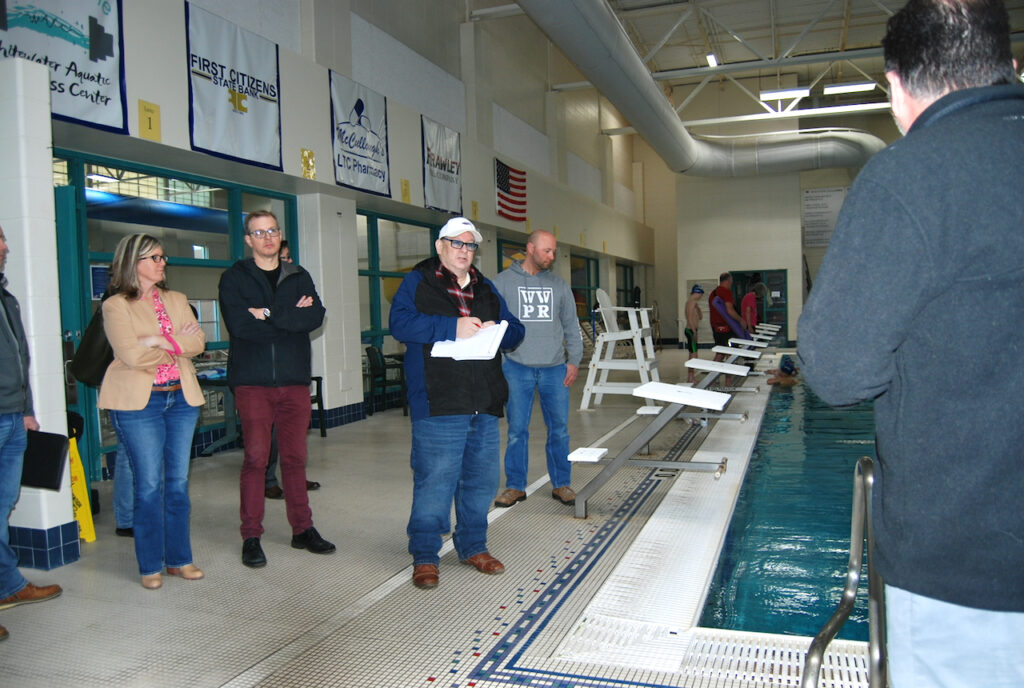
City of Whitewater and Whitewater Unified School District officials, many of whom also are members of the Whitewater Aquatic and Fitness Center Joint Subcommittee, tour the facility. The tour was held in February. A first meeting of the subcommittee was held in March. A third meeting will be Held Thursday, May 11, at the Whitewater Municipal Building. Kim McDarison photo.
This post has already been read 285 times!
Kim
Our Advertisers
Most Read Posts
- No results available
Categories
- Advertisers
- Area events
- Art, culture
- Business
- Community
- County
- Crime, court
- Culture
- Diseases
- Economics
- Food
- Government
- International
- Law and Court
- Lifestyle
- Obituaries
- Opinion
- Police, fire, EMS
- Religion
- School
- Science
- Technology
- Today's features
- Today's news
- Top Stories
- Travel
- Uncategorized
- University
- World











